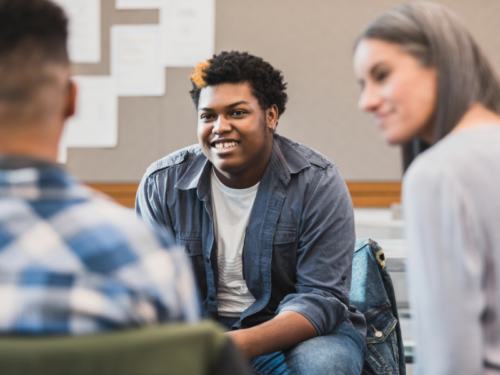
Nearly three million veterans of the post-9/11 generation have entered higher education without service. These students don’t fit the mold of a traditional 18- to 22-year-old higher student—a majority are older than other students, married with children, twice as likely to have a job off-campus, and have considerable life wits surpassing starting postsecondary school. How can colleges and universities tailor support for the health and well-being of higher student veterans?

The Institute for Veterans and Military Families (IVMF) estimates veterans make up 3-4% of higher students in America. They victorious on campus with global experiences, wholesale diversity, and a transferral to service. In classrooms, on sturdy fields, and in student organizations, student veterans are proving resilient, resourceful, entrepreneurial, and whiz at team building. And they’re mature vastitude their years, honest, and fiercely loyal to the institution. They often exercise dynamic leadership skills tested and proven under the most stressful conditions imaginable.
Student military veterans are a diverse group, as highlighted in the demographics from the Student Veterans’ Association (SVA) Census Survey:
In keeping with overall U.S. population trends, the Pew Research Part-way reports that the veteran population is expected to wilt increasingly racially and ethnically diverse. Projections moreover indicate that the veteran population will wilt slightly younger, with 33% of veterans stuff younger than 50 in 2046 compared with 27% in 2021. All of that to say, it’s increasingly important for colleges and universities to consider how to support the health and well-being of higher student veterans.
While military wits has led some to wonk success, it moreover presents unique challenges that can negatively impact grades and retention. From feeling 10 to 20 years older than everyone else in the classroom to struggling with physical disabilities, student veterans squatter variegated issues than typical students when furthering their education. These problems can be managed with strategic planning. The first step in overcoming these challenges is understanding what they are.
Adapting to campus and civil life without zippy duty can have a negative impact on GPA. The American Higher Personnel Association lists contributing factors such as starting school without a unravel and balancing work, school, and personal responsibilities. Adapting to campus life requires student veterans to retread to new structures, hierarchies, and expectations. “The wits of cultural incongruence and difficulty with peers and sense have both been shown to negatively impact wonk performance as it affects student veterans’ sense of belonging. This lack of belonging can be particularly true for veterans who do not hold traditionally predominant or privileged identities in the military (white, straight, men) who may finger unseen on campus and may not utilize veteran resources.”
The U.S. Department of Veterans Affairs (VA) reports that student veterans’ perceptions of their potential for wonk success are mixed. Some report a readiness for schoolwork that’s heightened by their military experience. Other students have concerns well-nigh meeting wonk standards. Military courses and training can be quite duty-specific and practical, while higher classes and assignments can be increasingly unstipulated and abstract. “Student veterans spend increasingly time preparing for classes and talking with instructors outside of matriculation than civil students do. However, student veterans are less likely to participate in experiential learning opportunities, such as internships or practicums.”
Despite the availability of mental health and well-being services from providers on campuses wideness the U.S., seeking mental health support may not finger straightforward for student veterans. Studies show student veterans perceive seeking help for mental health as stigmatized at higher rates than their non-veteran peers. They’re moreover less likely to believe in medication use for improving mental health. Katherine Street, a mental health provider at TimelyCare is a U.S. Air Force Veteran. She said, “In the military and supervenient in college, I recognized that the culture of stoicism and mental health stigma in the military was likely worsening problems among zippy service and retired military members and veterans.” She adds, “Part of reversing stigma and normalizing mental health superintendency is to ease wangle to services, so we can meet increasingly veterans on their terms. Virtual care, where veterans can connect with a counselor or participate in other services from their home, is proving to be constructive at expanding that wangle and engagement.”

The VA reports that some student veterans deal with physical and emotional disabilities. Nearly two-thirds of all student veterans stated that they have at least one VA powerlessness rating. This ways they had a service-connected condition that made them eligible for monthly compensation. Among these students, 75% reported that their disability impacts their educational experience. According to the VA, the two most worldwide physical disabilities for veteran students are:
Additionally, nearly one-third of student veterans deal with the invisible wounds of war like traumatic smart-ass injury, post-traumatic stress disorder, major depression, or anxiety. These conditions can impact school performance and the worthiness to concentrate and well-constructed assignments.
Government studies to assess mental health symptoms, suicidal ideation/behaviors, and treatment among student veterans found that 14.6% of student vets enrolled in a postsecondary school thought well-nigh suicide—with 36.9% screening positive for depression. Data moreover showed that student veterans have significantly higher rates of suicidal ideation and attempts compared to non-veteran higher students. A survey of 483 veterans enrolled at 71 colleges conducted by Inside Higher Ed found:
Additional factors include:
Here are resources colleges and universities can make misogynist to support student veteran success:

Many of the challenges veterans encounter with higher services and health professionals are clear—either the higher lacks defended staff knowledgeable in veterans’ issues and resources or they lack cultural sensation to interact with veterans appropriately. These issues can be solved by investing in resources, recruiting quality staff, and delivering regular training on veteran culture and service member needs. Inside Higher Ed outlines the pursuit initiatives to write student veterans’ healthcare needs:
Find increasingly weightier practices at Blog.CampusGroups.com and BestColleges.com.
Telehealth can be expressly constructive with student veterans—it’s fast, easy, and efficient. It eliminates wait times, reduces the stigma of seeking mental and medical care, and is misogynist the moment a student needs care. When students with military backgrounds don’t have to wait days or weeks for a counseling part-way appointment, they are unseat to finger supported, helping them reach their higher education goals.
Disclaimer: SPIRITUAL DEVOUT claims no credit for images featured on our blog site unless otherwise noted. All visual content is copyrighted to its respectful owners.
